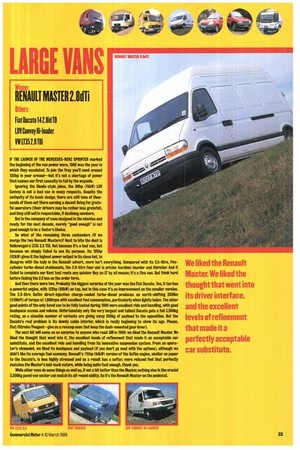LARGE VANS
Page 35

If you've noticed an error in this article please click here to report it so we can fix it.
Winner:
RENAULT MASTER 1.8dTi
Others: Fiat Ducat° 14 2.8id TO IVY Convoy Hi-loader VW1.135 2.8 Di
IF THE LAUNCH OF THE MERCEDES-BENZ SPRINTER marked the beginning of the van power wars, 1998 was the year In which they escalated. To join the fray you'll need around 120hp in your armour—but it's not a shortage of power that causes our first casualty to fall by the wayside.
Ignoring the Skoda-style jokes, the 991ip (74kW) LDV Convoy is not a bad van in many respects. Despite the antiquity of its basic design, there are still tens of thousands of them out there earning a decent living for grateful operators (their drivers may be rather less grateful), and they still sell in respectable, if declining numbers.
But in the company of vans designed in the nineties and ready for the next decade, merely "good enough" is not good enough to be a Tester's Choice.
So what of the remaining three contenders (if we merge the two Renault Masters)? Next to bite the dust is Volkswagen's LT35 2.8 TDI. Not because it's a bad van, but because we simply failed to see its purpose. Its 125hp (92kW) gives it the highest power output in its class but, to disagree with the lady in the Renault advert, more isn't everything. Compared with its 2.5-litre, fivecylinder turbo-diesel stablemate, the 2.8-litre four-pot is pricier, harsher, heavier and thirstier. And it failed to complete our Kent test route any quicker. Buy an IT by all means; it's a fine van. But think hard before ticking the 2.8 box on the order form.
And then there were two. Probably the biggest surprise of the year was the Fiat Ducat°. Yes, it too has a powerful engine, with 122hp (90kW) on tap, but in this case it's an improvement on the smaller version. The 2.8-litre Sofim direct-injection charge-cooled turbo-diesel produces an earth-shifting 285Nrn (210Ibft) of torque at 1,800rpm with excellent fuel consumption, particularly when lightly laden. The other good points of the only Sevel wan to be fully tested during 1998 were excellent ride and handling, with good loadspace access and volume. Unfortunately only the very longest and tallest Ducato gets a full 3,500kg rating, so a sizeable number of variants are giving away 250kg of payload to the opposition. But the Ducato's real problem is its dowdy cabin Interior, which is really beginning to show its age. Please, Fiat/Citroen/Peugeot—give us a revamp soon (but keep the dash-mounted gear lever).
The next bit will come as no surprise to anyone who read CH in 1998: we liked the Renault Master. We liked the thought that went into it, the excellent levels of refinement that made it an acceptable car substitute, and the excellent ride and handling from its innovative suspension system. From an operator's viewpoint, we liked its leadspace and payload (if you don't go mad with the options), although we didn't like its average fuel economy. Renault's 115hp (84k W) version of the Salim engine, similar on paper to the Borate's, is less highly stressed and as a resat has a softer, more relaxed feel that perfectly matches the Master's laid-back nature, white being quite fast enough, thank you.
While other vans do some things as well as, if not a bit better than the Master, nothing else in the crucial 3,500kg panel van sector can match Its all-round ability. So it's the Renault Master on the pedestal.








































































































